| Srl | Item |
| 1 |
ID:
151137
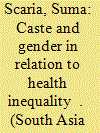

|
|
|
|
|
| Summary/Abstract |
This article is based on a micro-level village study in
Kerala, the southernmost Indian state with its long-standing
impressive basic indicators in health, economic growth and social
development. Using the theoretical perspective of ‘cultural inflation
of morbidity’ for a hypothesis of continuing inequities in health
outcomes, it examines how far such impressive basic indicators have
actually translated into equity in health outcomes, defined in terms
of incidence of morbidity and morbidity pattern. Confirming the
hypothesis, the findings discuss to what extent both caste and gender,
separately and together, may be continuing today to mediate health
outcomes in a changing socio-economic environment.
|
|
|
|
|
|
|
|
|
|
|
|
|
|
|
|
| 2 |
ID:
151141
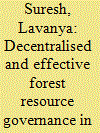

|
|
|
|
|
| Summary/Abstract |
Within the context of decentralised environmental governance, this article seeks to answer the question which institutional arrangements may be most effective in delivering the promise of better community-centred forest governance. The specific objective is to analyse the impact that decentralisation of resource management has on the effectiveness of forest governance. Using a comparative case study framework, the article finds that decentralisation functions better when nested structures with a plurality of bodies are in operation. However, the case studies also highlight the need for constant monitoring as a necessarily ongoing crucial process to protect the ecological sustainability of forest resource governance as well as strengthening equitable social structures at the village level.
|
|
|
|
|
|
|
|
|
|
|
|
|
|
|
|
| 3 |
ID:
151139
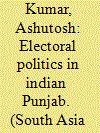

|
|
|
|
|
| Summary/Abstract |
The forthcoming Assembly elections in Punjab in early
2017 indicate signs of a new phase in the electoral history of this
state, largely dominated earlier by various political alliances headed
by the Shiromani Akali Dal (SAD) under Jat Sikh leadership.
Presented within the wider Indian electoral landscape, this article
offers an analytical overview of Punjab’s electoral politics as it has
evolved since partition from the vantage point of SAD. It is argued
that there are several good reasons why traditional SAD domination
and style of leadership are presently being challenged through a
combination of new political actors and, significantly, changing
awareness among a very diverse electorate about what to expect
from any government one elects.
|
|
|
|
|
|
|
|
|
|
|
|
|
|
|
|
| 4 |
ID:
151142
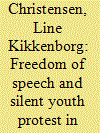

|
|
|
|
|
| Summary/Abstract |
T This article suggests that a political censorship regime
exists in Bhutan and that appeals to ensure security and sovereignty
of the country, rather than power, are used to uphold this regime.
Fieldwork uncovers that fear of how authorities may punish
anyone in open opposition is widespread among Bhutanese college
students. A number of political issues are characterised as ‘sensitive’
by informants and skilful navigation around them is needed. The
perception of free speech as limited inspires self-censorship in public
and in private among Bhutanese college students. Free speech is
practised in culturally specific ways and online, where anonymous
opposition against the established correct ‘non-discourse’ is known
as ‘silent protests’.
|
|
|
|
|
|
|
|
|
|
|
|
|
|
|
|
| 5 |
ID:
151138
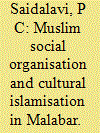

|
|
|
|
|
| Summary/Abstract |
This article calls for a re-evaluation of basic concepts
such as caste and status groups for making sense of the social
organisation of Muslims in Malabar. Muslim social groups, while
disseminating notions of egalitarian claims of Islam, rationalise
social divisions and discriminatory practices among themselves
largely in terms of Islamic juristic concepts of purity, knowledge,
piety and morality. Due to increasing Islamisation, these notions
have been reconstructed to sustain social divisions among Muslims.
Therefore, it is argued here that social divisions among Muslims in
Malabar today do not derive primarily from acculturative influences
of Hinduism. The article concludes that since sociological concepts
such as caste, ethnicity and status groups as used in South Asia have
failed to capture this Islamic cultural mediation, these phenomena
need to be further researched.
|
|
|
|
|
|
|
|
|
|
|
|
|
|
|
|
| 6 |
ID:
151140
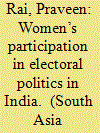

|
|
|
|
|
| Summary/Abstract |
The recent participation levels of women in formal
politics in India reveal two positives that augur well. First, the
upsurge among women voters that started in the 1990s reached the
highest female turnout ever, so far, in the 2014 Lok Sabha elections.
Second, women’s participation in high-voltage election campaigns
during the 2014 general elections also showed a substantial
increase. However, the continued under-representation of women
in legislative bodies and within the rank and file of political parties
offsets the momentous gains made in the people-driven feminisation
of electoral politics in India.
|
|
|
|
|
|
|
|
|
|
|
|
|
|
|
|